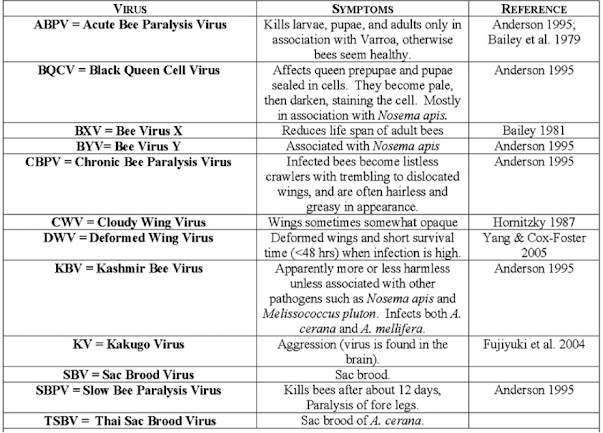Why is the Varroa Mite so Damaging to Honey Bees?
The term symbiosis is used to define the way that certain organisms interact. This word broken down from the original Greek simply means “living together”. Any dissimilar organisms which live together long-term, must have a relationship which allows both to more or less survive symbiotically. There are three options when it comes to symbiotic relationships: commensalism, mutualism and parasitism.Examples of all three types of symbiotic relationships can be found when looking at honey bee colonies. The benefit to both the plants and the honey bees during pollination is an excellent instance of mutualism. Commensalism is where neither of the participants in the symbiotic relationship are harmed but one will gain some benefit. This is exemplified in the relationship between the honey bee and the bee louse (Braula coeca) which lives on the bees but seemingly causes them no harm. Parasitism is the final symbiotic relationship and worth some further discussion.
 |
| Varroa Mite |
Parasitism is a symbiotic relationship where one of the organisms benefits at the detriment of the other. Parasitism has been referred to as the “dark side” of symbiosis. Beekeeping has an excellent, although slightly horrific, example of extreme parasitism in which fly eggs are injected into bees, resulting in brain-eating larva, leading to ZomBees (see Apocephalus borealis). In honey bee colonies, we see two categories of parasite. Parasites that live on the outside of the host organism, called ectoparasites, and those that live on the inside of the organism called endoparasites. Many parasites will only survive on a specific host for part of their lifecycle but a ‘permanent parasite’ spends its entire life cycle with one host as seen with the Varroa mite.
Often times, when the host and the parasite evolve in close proximity, the parasitic relationship is less damaging. When a new parasite arrives in an area to invade a novel host, the parasite may overwhelm the host. As a natural host, the Asian honey bee (Apis cerana) is Varroa tolerant but the European honey bee (Apis mellifera) is a naïve host and therefor intolerant. This means that our European honey bee does not have the mechanisms to defend as well against Varroa. Worth mentioning is the fact that acaricide use does not allow Apis mellifera to develop a natural host parasite balance with the Varroa mite.
In itself, as a parasite, the Varroa mite is damaging to European honey bees but it is also a vector for other diseases. This is an additional reason why it is so deadly! The table below contains a list of the viruses that we believe are transmitted by Varroa. The most visible of these diseases is the Deformed Wing Virus and experienced beekeepers know the resulting damaged wings are an indicator of high Varroa mite numbers.
Table 1. Viral infections of Honey Bees transmitted by Varroa destructor. Adapted from Kevan et al., 2006*
*Kevan, P. G., Hannan, M.A., Ostiguy, N., and Guzman-Novoa, E. "A Summary of the Varroa-Virus Disease Complex in Honey Bees" American Bee Journal (August 2006): 694-697
The damaging story of the Varroa mite gets worse! Not only does the Varroa mite transmit viruses, it seems, that in some cases, two honey bee pathogens collude together for a compounded, negative effect. The Deformed Wing Virus (DWV) and the Varroa mite have a mutual symbiosis. In an interesting paper, published by a team of researchers from Ohio State University, it has been shown that the mites transmit the DWV to the honey bee colonies. The DWV infection suppresses the immune system of the honey bees which facilitates the feeding of the parasitic mites. These researchers suggest that the immunosuppressive effect of the virus also aids in reproduction for the Varroa mites. A fascinating and complex interaction which is ultimately detrimental to the honey bees.
There has also been a positive correlation between Varroa mite and nosema infestation. Meaning that the higher the Varroa burden the higher the nosema levels. Although no direct causation is proven by this relationship, it is a worrying result. From this it could be argued that a Varroa weakened hive is more susceptible to other pathogens, pests and diseases. One recent study supports this hypothesis in reporting the down regulation of genes related to immunity in honey bees with higher Varroa infestations. This effect on the honey bees immune function and subsequent ability to defend against pathogens would increase susceptibility to disease.
Varroa destructor is a threat to honey bees on many levels. The weakening effects due to loss of fat body tissue, transmission of viral and other diseases, weakening of immune function all combine in a perfect storm of honey bee ill health. These, together with the adaptability of the mite in developing resistance to acaricides, make the Varroa mite a deadly threat to our honey bees. The honey bee / Varroa mite relationship is complicated further by beekeeping practices. We expect Varroa mites to adapt and develop resistance to the regular, long term use of acaricides. The application of acaricides also prevents the honey bees from adapting to, living with and developing better mechanisms to control Varroa mites. So as beekeepers we are expecting adaptation from the Varroa mites and preventing adaptation of our honey bees. Undertaking an explanation to this perplexing, counter intuitive expectation is beyond the capacity of these few paragraphs of our blog. Perhaps this is an interesting consideration when looking towards the future of Varroa mite control.
Connecting with ATTTA Specialists
If you’d like to connect with ATTTA specialists or learn more about our program, you can:
visit our website at https://www.perennia.ca/portfolio-items/honey-bees/
Email abyers@perennia.ca
Thanks for following along with our blog and keeping up with the ATTTA buzz & don't forget to subscribe!

